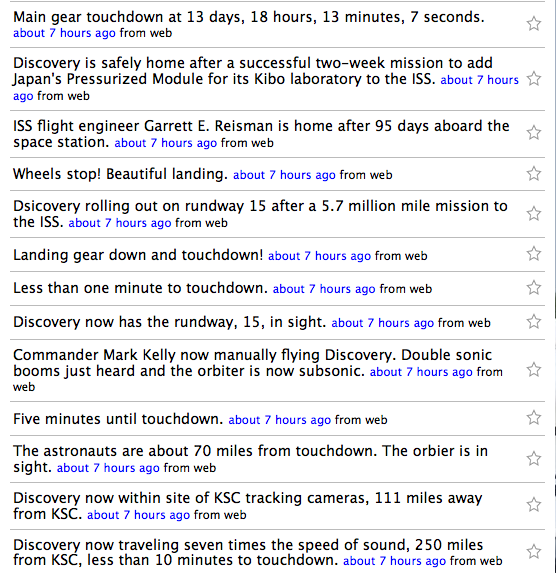When I was a kid, I wanted to be an astronaut. Hell, when *you* were a kid, you wanted to be an astronaut. Then, one day, we grew up and realized we were destined for more traditional careers like lawyers, accountants or *gasp* social media consultants. Yeah, we didn’t end up quite as sexy as we hoped we would in those days of being of single-digit age.
Today, my son and I watched Shuttle Discovery land online at NASA TV. He loved it and promptly said, “Daddy, I want to fly a spaceship when I get big”. I invited him over to watch after discovering that yet another NASA initiative was using social media. They were using Twitter (@STS124), in this case, to tweet the landing.

This is not the first time in recent weeks that NASA has used social media. The Phoenix lander on Mars is still sending tweets back from the Red Planet – though we obviously believe this is some savvy user or group of users in Houston Pasadena, CA and not the lander itself.
Though NASA TV broadcasts on almost every cable or satellite outlet, no one actually turns that on – that I know of. That’s because it’s often as dull and non-compelling as CSPANs programming. However, they are using social media to capture the moments that we will one day look back on and tell our kids about are indeed inspiring the imagination of a new generation who missed out on the space race decades ago.
President Kennedy inspired this imagination on May 25, 1961 when he aggressively informed Congress that he wanted a man on the moon within the decade.
I believe that this nation should commit itself to achieving the goal, before this decade is out, of landing a man on the Moon and returning him safely to the Earth. No single space project in this period will be more impressive to mankind, or more important for the long-range exploration of space; and none will be so difficult or expensive to accomplish. We propose to accelerate the development of the appropriate lunar space craft. We propose to develop alternate liquid and solid fuel boosters, much larger than any now being developed, until certain which is superior. We propose additional funds for other engine development and for unmanned explorations–explorations which are particularly important for one purpose which this nation will never overlook: the survival of the man who first makes this daring flight. But in a very real sense, it will not be one man going to the Moon–if we make this judgment affirmatively, it will be an entire nation. For all of us must work to put him there.
Today, we have a shuttle launch every few months. We get jarred back to the reality of the danger of the adventure that is space with tragic accidents such as the Challenger or Columbia disasters, but soon enough, going into space becomes, yet again, a routine thing that is not all that riveting.
NASA has every intention of returning to the moon by 2020 and Russia wants to build a permanently manned lunar base by 2027. Do I have your attention yet?
In 1969, people woke up at 4am to huddle around tiny black and white televisions to watch Neil Armstrong become the first man to step foot on the moon uttering those historic words, “That’s one small step for man, one giant leap for mankind.” Today, we’re huddling around internet-connected computers sharing historic space moments via uStream – where we watched the Mars Landing (SpaceVidCast not officially connected with NASA). We watched the tweet streams come in as we sensed the whole world was watching – again.
NASA is recapturing the imaginations of a generation all over again and using our tools to do it. All the kids are coming back to the show again and we all want to be astronauts. Again.
